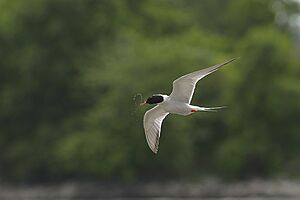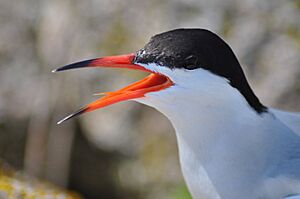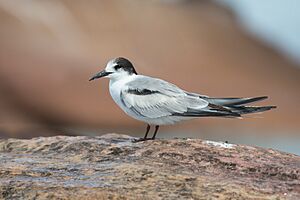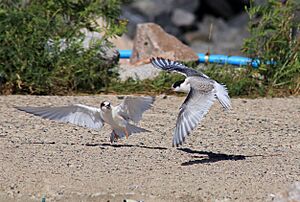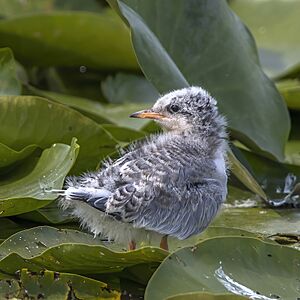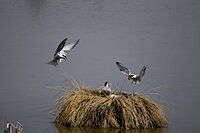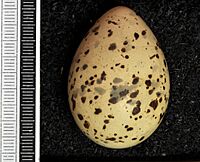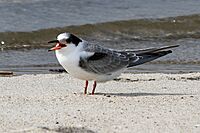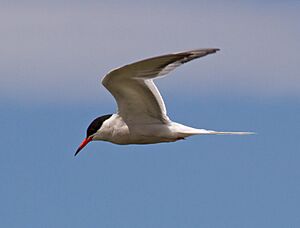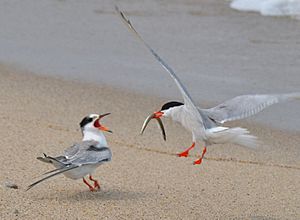Common tern facts for kids
Quick facts for kids Common tern |
|
|---|---|
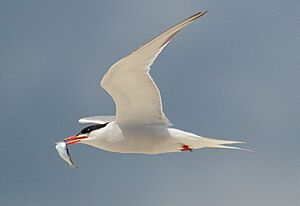 |
|
| Conservation status | |
| Scientific classification | |
| Genus: |
Sterna
|
| Species: |
hirundo
|
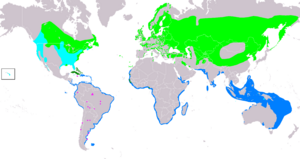 |
|
| Breeding Resident Non-breeding Passage Vagrant (seasonality uncertain) | |
| Synonyms | |
|
|
The common tern (Sterna hirundo) is a type of seabird that belongs to the Laridae family. These birds live all around the world, in many parts of Europe, Asia, and North America. They love to breed in places with mild or cool weather.
Common terns are strong migratory birds. This means they fly long distances. They spend their winters in warmer coastal areas, like the tropical and subtropical regions.
Adult common terns have light grey feathers on their backs and white or very light grey feathers underneath. They have a black cap on their heads, orange-red legs, and a thin, pointed beak. Their beak can be mostly red with a black tip, or completely black, depending on where they live.
There are other terns that look similar, like the Arctic tern. You can tell them apart by small differences in their feathers, leg and beak colors, or their calls.
Common terns can nest in many different places. They like flat, open areas near water, such as beaches and islands. They can even use man-made spots like floating platforms. Their nest is often just a small dip in the sand or gravel. Sometimes, they add bits of plants or shells around it.
They usually lay up to three eggs. These eggs have dull colors and blotchy patterns. This helps them blend in and stay hidden on the beach. Both parents take turns sitting on the eggs to keep them warm. The eggs hatch in about 21–22 days. The fluffy chicks are ready to fly in 22–28 days.
Like most terns, common terns catch fish by diving headfirst into the water. They can hunt in the sea or in freshwater. Sometimes, they also eat molluscs, crustaceans, and other small invertebrates.
Young terns and eggs can be eaten by animals like rats and American mink. Larger birds, such as gulls, owls, and herons, also hunt them. Common terns can get lice, parasitic worms, and mites.
Even though their numbers have dropped in North America, the common tern is still considered a species of least concern. This is because they have a very large population and live across a huge area. Laws protect them, but in some places, their homes are still threatened by pollution or human activity.
Contents
About Common Terns
Terns are small to medium-sized seabirds. They are related to gulls, skimmers, and skuas. Terns look a bit like gulls but are usually lighter. They have long, pointed wings that help them fly fast and gracefully. They also have a deeply forked tail, thin legs, and webbed feet. Most terns are grey on top and white underneath. They have a black cap on their heads, which gets lighter in winter.
The common tern's closest relatives are the Antarctic tern, Arctic tern, and roseate tern. Scientists believe the common tern might have developed earlier than these other terns.
Carl Linnaeus first described the common tern in 1758. He gave it the scientific name Sterna hirundo. The word "Sterna" comes from an old English word for these birds. "Hirundo" is Latin for swallow. This name refers to how the tern looks like a swallow, with its light body and long, forked tail. Because of this, people sometimes call them "sea swallows."
There are four main types, or subspecies, of the common tern. They live in different parts of the world and have slight differences in their looks.
| Subspecies | Where it lives | What makes it special |
|---|---|---|
| S. h. hirundo | Europe, North Africa, Asia (west Siberia, Kazakhstan), and North America. | North American birds have slightly shorter wings. Birds from Scandinavia and eastern Eurasia have more black on their beak tips. |
| S. h. minussensis | Near Lake Baikal to northern Mongolia and southern Tibet. | Paler grey feathers than S. h. longipennis. It has a crimson beak with a black tip. |
| S. h. longipennis | Central Siberia to China, also Alaska. | Darker grey than the main subspecies. It has a shorter black beak, darker red-brown legs, and longer wings. |
| S. h. tibetana | Himalayas to southern Mongolia and China. | Similar to the main subspecies but with a shorter beak and a wider black tip. |
How Common Terns Look
The common tern is about 31 to 35 cm (12 to 14 inches) long. This includes its tail, which has a 6 to 9 cm (2.4 to 3.5 inches) fork. Its wings can spread from 77 to 98 cm (30 to 39 inches). It weighs about 110 to 141 grams (3.9 to 5.0 ounces).
When breeding, adults have light grey backs and very pale grey undersides. They have a black cap, orange-red legs, and a thin, pointed beak. The beak can be mostly red with a black tip, or all black. Their upper wings are pale grey. As summer goes on, a dark grey patch appears on their wings. Their rump and tail are white. When standing, their tail does not stick out past their folded wings. Males and females look very similar.
When not breeding, adults have a white forehead and white undersides. Their beak is all black or black with a red base. Their legs are dark red or black. Their upper wings have a clear dark bar at the front edge.
Young common terns have pale grey upper wings with a dark bar. Their head is brown, and their forehead is a bit ginger. This ginger color turns white by autumn. Their back is ginger with brown and white scales. Their tail does not have the long outer feathers that adults have.
The common tern is a very skilled flyer. It can turn quickly, swoop, hover, and take off straight up. When carrying fish, it flies low in strong winds. But it flies higher, about 10 to 30 meters (33 to 98 feet), in light winds. It usually stays below 100 meters (330 feet) and flies at about 30 kilometers per hour (19 mph). During night migrations, it flies faster, about 43 to 54 kilometers per hour (27 to 34 mph), at a height of 1000 to 3000 meters (3,300 to 9,800 feet).
Similar Birds
There are several terns that look similar to the common tern. It can be hard to tell them apart, especially the Arctic tern. For a long time, people often called them "commic terns" when they couldn't tell which was which.
The common tern has a larger head, thicker neck, longer legs, and stiffer wings than the Arctic tern. It also flies more directly. Arctic terns have greyer undersides, which makes their white cheeks stand out more. The common tern's rump can be greyish in winter, while the Arctic tern's is white. As summer goes on, the common tern gets a dark patch on its wings, but the Arctic tern's wings stay white.
The beak of an adult common tern is orange-red with a black tip. Its legs are bright red. The Arctic tern has darker red legs and beak, and its beak usually doesn't have a black tip.
The roseate tern can be identified by its pale feathers, long, mostly black beak, and very long tail feathers. It also flies with heavier head and neck movements and faster wingbeats.
In North America, the Forster's tern is larger than the common tern. It has shorter wings, a heavy head, a thick beak, and long, strong legs. In winter, its white head and dark eye patch make it easy to spot.
Voice and Calls
Common terns make many different sounds. Their calls are lower in pitch than those of Arctic terns. The most common sound is an alarm call, KEE-yah, with the stress on the first part. This is different from the Arctic tern, which stresses the second part. The alarm call also warns intruders. If there's a serious threat, they make a kyar sound as they fly away. This makes the colony quiet while the birds check for danger.
When an adult tern brings a fish to the nest, it makes a soft, down-slurred keeur sound. This call might help chicks recognize their parents. Another common call is a kip sound, used when birds meet each other. They also make a kakakakaka sound when attacking intruders, and a quick kek-kek-kek when males fight.
Parents and chicks can find each other by their calls. Young terns also recognize their siblings' calls after about 12 days. This helps them stay together.
Where Common Terns Live
Most common terns fly long distances for winter. They breed in the Northern Hemisphere and spend winter in warmer areas to the south. Young birds usually stay in their winter homes for their first summer.
In North America, common terns breed along the Atlantic coast from Labrador to North Carolina. They also breed inland across much of Canada and the Great Lakes region. Some small groups live in the Caribbean, like in The Bahamas and Cuba.
Birds from the New World spend winter along the coasts of Central and South America. They go as far south as Argentina and northern Chile. Some birds may even fly across the Atlantic Ocean during their migration.
Common terns breed across most of Europe, especially in the north and east. Small groups are found on the north African coast and islands like the Azores. Most European birds spend winter off western or southern Africa.
The breeding range continues across Asia, with some groups in the Persian Gulf and Iran. Small groups breed on islands near Sri Lanka and in the Tibetan plateau. Asian birds winter in the northern Indian Ocean and the western Pacific, reaching southern Australia. A tern tagged in Sweden was found in New Zealand, having flown about 25,000 km (15,000 miles)!
Common terns can live in many different places. They nest near freshwater or the sea on open, flat land. This includes sand or pebble beaches, firm dunes, or islands. They avoid places with too much rain, wind, or icy water. They can even nest on artificial floating platforms or flat factory roofs.
Outside of breeding season, they just need places to fish and land. They use natural beaches and rocks, but also boats, buoys, and piers to rest.
Common Tern Behavior
Home and Territory
Common terns live in groups called colonies. These colonies usually have up to two thousand pairs of birds, but sometimes they can have more than twenty thousand pairs! Inland colonies are usually smaller than those on the coast. Common terns often nest near other seabirds like Arctic terns and gulls.
When they return to their breeding sites, terns might wait a few days before settling down. Nesting often starts when there are lots of fish available. Terns only defend a small area around their nest. Nests can be as close as 50 cm (20 inches) apart, but usually they are 150 to 350 cm (59 to 138 inches) apart.
Many birds use the same nesting spot year after year. One pair was recorded returning for 17 years in a row! About 90% of experienced birds use their old territory. This means young birds have to find new spots or mates. The male chooses a nesting spot a few days after arriving in spring. His partner from the previous year usually joins him.
Males mainly defend the territory. They chase away other terns. They make an alarm call, open their wings, raise their tail, and bow their head to show their black cap. If an intruder doesn't leave, the male might fight it by grabbing its beak. They also attack birds flying over their territory. Even though adults are aggressive, they usually don't attack wandering chicks from other nests. All the adults in the colony work together to scare away predators.
Raising Young
Common terns find their partners through special flights. A male and female fly in wide circles, high in the sky, calling to each other. Then they glide down together in zigzags. If the male has a fish, he might get attention from other males too. On the ground, the male circles the female with his tail and neck raised. He might offer her the fish.
Once they are a pair, the male makes a small dip in the sand. The female then scratches in the same spot. They might try several spots before choosing the final nest site. The eggs can be laid on bare sand, gravel, or soil. Often, they add bits of plants, stones, or shells around the nest. The nest is a shallow dip, about 4 cm (1.6 inches) deep and 10 cm (3.9 inches) wide.
Terns are very good at finding their nests in a large colony. They can even find their eggs if they are buried or if the nest is moved a few meters away. This skill helps them in places where the wind or tides can change the beach.
The best time for laying eggs is early May. Some birds, especially those breeding for the first time, lay eggs later in May or June. They usually lay three eggs. Each egg is slightly smaller than the one laid before it. The eggs are cream, buff, or pale brown, with black, brown, or grey marks. These marks help hide the eggs.
Both parents take turns sitting on the eggs, though the female does it more often. Incubation lasts 21–22 days. If the colony is disturbed often, it can take longer. On hot days, the parent might wet its belly feathers in water to cool the eggs. About 90% of the eggs hatch.
The fluffy chicks are yellowish with black or brown marks. They are similar to Arctic tern chicks. The chicks learn to fly in 22–28 days. After they can fly, they are fed at the nest for about five more days. Then they go with the adults on fishing trips. Parents may continue to feed their young until the end of the breeding season, and even during migration.
Common terns are very protective of their nests and young. They will bother humans, dogs, and most daytime birds. But unlike the more aggressive Arctic tern, they rarely hit intruders. They usually swerve away at the last moment. They can tell different humans apart and attack familiar people more strongly. They don't attack night predators like owls, which can wipe out colonies.
Common terns usually breed once a year. They might lay a second set of eggs if the first ones are lost. They usually start breeding when they are four years old, sometimes three. The number of young that survive can vary a lot, from none if the colony floods, to more than 2.5 in a good year. Birds get better at raising chicks as they get older. The longest recorded lifespan in the wild is 23 years in North America and 33 years in Europe, but 12 years is more common.
Food and Hunting
Like all Sterna terns, the common tern catches fish by diving into the water. They dive from about 1 to 6 meters (3 to 20 feet) high. They can hunt in the sea or in freshwater lakes and large rivers. The bird might go under the water for a second or two, but no deeper than 50 cm (20 inches).
When looking for fish, the tern flies with its head down and beak pointing straight down. It might circle or hover before diving. Common terns usually hunt 5 to 10 km (3 to 6 miles) away from their nesting colony. Sometimes they go as far as 15 km (9 miles). They will follow groups of fish. They also watch for groups of predatory fish or dolphins, waiting for them to drive prey to the surface. Terns often hunt in groups, especially when there is a lot of food. Hunting in a group is usually more successful than hunting alone.
Terns have special red oil droplets in their eyes. These help them see better, especially in hazy conditions. This improved eyesight helps them find groups of fish.
Common terns prefer to hunt fish that are 5 to 15 cm (2 to 6 inches) long. The type of fish they catch depends on what is available. If they have a choice, terns feeding several chicks will catch larger fish. Fish can make up to 95% of their diet in some areas. But in other places, they eat a lot of invertebrates. This can include worms, leeches, small squid, and crustaceans like prawns and shrimp. In freshwater areas, they might catch large insects like beetles and moths. They catch adult insects in the air and pick larvae from the ground or water surface.
They catch prey with their beak. They either swallow it head-first or carry it back to their chicks. Sometimes, they can carry two or more small fish at once. When adults bring food back to the nest, they recognize their young by their calls, not just by sight.
Common terns sometimes try to steal fish from Arctic terns. But they can also have their fish stolen by other birds like skuas or gulls.
Terns usually drink while flying. They often prefer seawater over freshwater. Chicks do not drink before they can fly. Like adults, they get rid of extra salt from a special gland in their nose. Fish bones and hard shells from crustaceans or insects are coughed up as pellets. Adults fly away from the nest to go to the bathroom. Even small chicks walk a short distance from the nest to do their business. Adults attacking animals or humans will often poop as they dive, often hitting the intruder.
Threats and Conservation
Rats can eat tern eggs, and American mink are a big threat to hatched chicks. Red foxes can also be a problem in some areas. Since common terns nest on islands, other birds are usually more common predators than mammals. Ruddy turnstones will take eggs from unattended nests. Gulls may take chicks. Large owls and black-crowned night herons will kill both adult and young terns. Merlins and peregrine falcons may attack flying terns. Flying in groups helps confuse these fast predators.
Common terns can get feather lice and parasitic worms. They can also be infected by mites. However, blood parasites seem to be rare. Colonies have been affected by bird diseases like avian cholera. It's possible that bird flu could be a threat in the future, as common terns can catch it.
The common tern is listed as a species of least concern by the IUCN Red List. This means it is not currently at high risk of extinction. It has a large population of 1.6 to 3.3 million adult birds. Its breeding range is huge, covering about 84.3 million square kilometers (32.5 million square miles). About 140,000 pairs breed in Europe. Fewer than 80,000 pairs breed in North America.
In the 1800s, people used tern feathers and wings for hats. This caused a big drop in common tern numbers in Europe and North America. But their numbers mostly recovered in the early 1900s because of new laws and conservation groups.
Even though some European populations are stable, numbers in North America have fallen by more than 70% in the last 40 years. Overall, the global population is decreasing.
Threats include losing their homes due to building, pollution, or too much plant growth. Human activity, vehicles, boats, or dogs can also disturb breeding birds. Natural floods can destroy nests. Some colonies are also threatened by rats and large gulls, which also compete for nesting spots. In the Caribbean, some birds are hunted for food.
To help common terns, people use floating nest platforms or man-made islands. They also try to prevent human disturbance. Overgrown plants can be burned to clear nesting areas. Gulls can be scared away or removed. Pollution from chemicals like PCBs and DDT has also caused problems for breeding success in some areas.
The common tern is protected by international agreements like the Agreement on the Conservation of African-Eurasian Migratory Waterbirds (AEWA) and the US–Canada Migratory Bird Treaty Act of 1918. These agreements require countries to work on protecting the species and its habitats.
Images for kids



